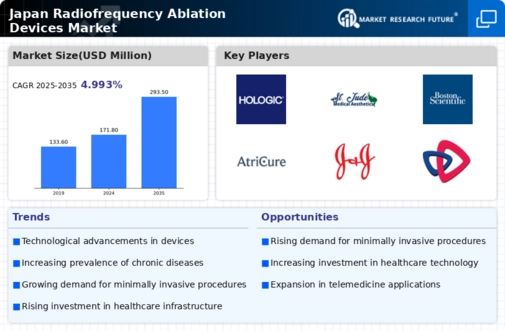Advancements in Medical Technology
Technological innovations play a crucial role in shaping the radiofrequency ablation-devices market. The introduction of advanced imaging techniques, such as MRI and CT-guided procedures, enhances the precision and efficacy of ablation treatments. These advancements not only improve patient safety but also increase the success rates of procedures. In Japan, the market for medical devices is projected to grow at a CAGR of around 8% over the next five years, driven by the integration of cutting-edge technologies. Furthermore, the development of next-generation ablation devices, which offer enhanced features such as real-time monitoring and automated systems, is likely to attract more healthcare facilities to adopt these solutions. As hospitals and clinics seek to provide high-quality care, the demand for technologically advanced radiofrequency ablation devices is expected to rise, thereby fostering growth in the industry.
Government Initiatives and Funding
Government support and funding initiatives are instrumental in driving the radiofrequency ablation-devices market. In Japan, the Ministry of Health, Labour and Welfare has been actively promoting the adoption of advanced medical technologies through various funding programs and subsidies. These initiatives aim to enhance healthcare delivery and improve patient outcomes. For instance, the government has allocated substantial budgets for research and development in medical devices, which includes radiofrequency ablation technologies. This financial backing not only encourages innovation but also facilitates the entry of new players into the market. As a result, the competitive landscape is likely to evolve, with more options available for healthcare providers. The ongoing commitment from the government to support healthcare advancements suggests a favorable environment for the growth of the radiofrequency ablation-devices market in Japan.
Increasing Prevalence of Chronic Diseases
The rising incidence of chronic diseases in Japan is a pivotal driver for the radiofrequency ablation-devices market. Conditions such as cancer, cardiac arrhythmias, and chronic pain are becoming more prevalent, necessitating effective treatment options. According to recent health statistics, approximately 30% of the Japanese population is affected by chronic diseases, leading to a growing demand for innovative medical technologies. Radiofrequency ablation offers a minimally invasive solution, which aligns with the preferences of both patients and healthcare providers. This trend is likely to continue, as the aging population further exacerbates the burden of chronic illnesses, thereby propelling the market for radiofrequency ablation devices. The healthcare system's focus on improving patient outcomes and reducing hospital stays also supports the adoption of these devices, indicating a robust growth trajectory for the industry in the coming years.
Growing Awareness Among Healthcare Professionals
The increasing awareness and education among healthcare professionals regarding the benefits of radiofrequency ablation are driving the market forward. Medical conferences, workshops, and training programs in Japan have been instrumental in disseminating knowledge about the efficacy and safety of ablation techniques. As more practitioners become familiar with these procedures, the adoption rates are expected to rise. This trend is particularly relevant in the context of interventional cardiology and oncology, where radiofrequency ablation is gaining traction as a preferred treatment option. The collaboration between medical institutions and device manufacturers to provide training and resources further enhances the understanding of these technologies. Consequently, the growing expertise among healthcare professionals is likely to contribute to the expansion of the radiofrequency ablation-devices market, as they advocate for its use in clinical practice.
Rising Patient Preference for Minimally Invasive Treatments
There is a notable shift in patient preferences towards minimally invasive treatment options, which is significantly influencing the radiofrequency ablation-devices market. Patients in Japan are increasingly seeking procedures that offer reduced recovery times, less pain, and minimal scarring. Radiofrequency ablation aligns perfectly with these preferences, as it is associated with shorter hospital stays and quicker return to daily activities. Industry expert's indicates that approximately 70% of patients express a preference for minimally invasive procedures over traditional surgical options. This trend is further supported by the growing body of evidence demonstrating the effectiveness of radiofrequency ablation in treating various conditions. As healthcare providers respond to these demands, the market for radiofrequency ablation devices is likely to experience substantial growth, reflecting the changing landscape of patient care.

















Leave a Comment